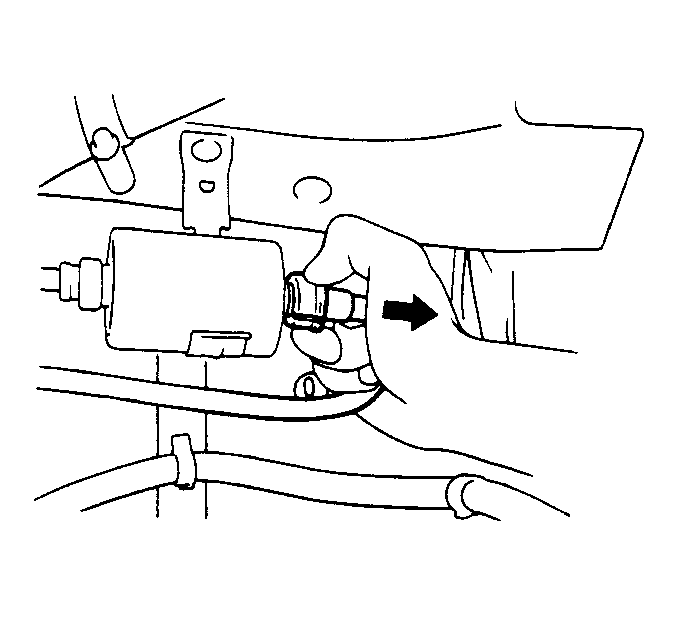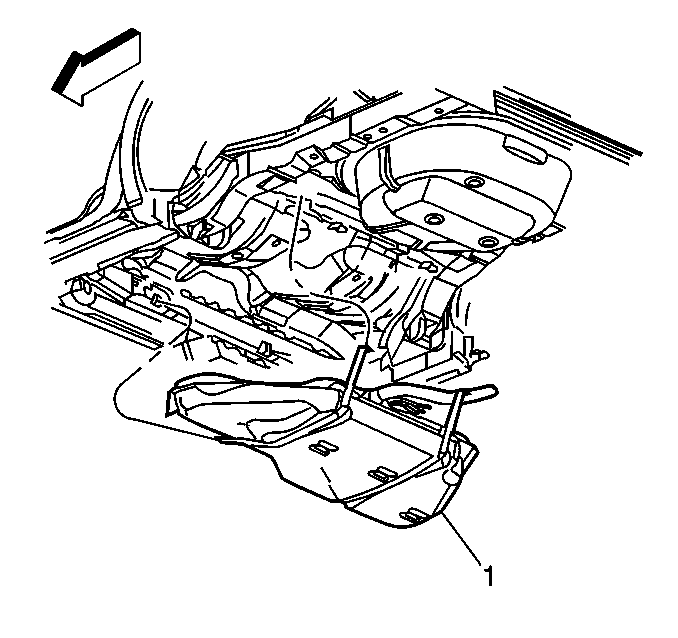Removal Procedure
- Drain the fuel tank. Refer to Fuel Tank Draining .
- Relieve the fuel system pressure. Refer to Fuel Pressure Relief .
- Raise and suitably support the vehicle . Refer to Lifting and Jacking the Vehicle in General Information.
- Disconnect the quick-connect fitting at the fuel filter. Refer to Plastic Collar Quick Connect Fitting Service .
- Disconnect the quick connect fittings at the end of the fuel lines. Refer to Metal Collar Quick Connect Fitting Service .
- Remove the rubber exhaust hangers. Allow the exhaust system to rest on the rear axle.
- Remove the exhaust heat shield.
- Loosen the fuel filler hose clamp at the fuel tank.
- Remove the hoses from the fuel tank filler, the EVAP vent, and the EVAP vapor pipes.
- Disconnect the electrical harness from the multi-way rear body connector and fuel strap.
- With the aid of an assistant, support the fuel tank (1) and disconnect the 2 fuel tank retaining straps.
- Lower the fuel tank.
- Disconnect the wiring harness from the modular fuel sender assembly and the fuel tank pressure sensor.
- Disconnect the EVAP pipe and the fuel pipe from the modular fuel sender and the fill limiter vent valve.
- Remove the fuel sender assembly from the tank. Refer to Fuel Sender Assembly Replacement .
Caution: To avoid any vehicle damage, serious personal injury or death when major components are removed from the vehicle and the vehicle is supported by a hoist, support the vehicle with jack stands at the opposite end from which the components are being removed and strap the vehicle to the hoist.


Installation Procedure
- Reinstall the fuel sender assembly to the fuel tank. Refer to Fuel Sender Assembly Replacement .
- Reconnect the fuel pipe and the EVAP pipe to the modular fuel sender and the fill limiter vent valve.
- Reconnect the wiring harness to the modular fuel sender assembly and the fuel pressure switch.
- With the aid of an assistant, raise the fuel tank (1) to the vehicle.
- Reinstall the fuel tank retaining straps.
- Reconnect the wiring harness into the multi-way rear body connector.
- Reconnect the hoses to the fuel tank filler, EVAP vent and EVAP vapor pipes
- Tighten the filler hose clamp at the fuel tank.
- Reinstall the rubber exhaust hangers.
- Reconnect the nylon fuel line and fuel filter quick-connect fittings. Refer to Plastic Collar Quick Connect Fitting Service .
- Lower the vehicle.
- Refill the tank and reinstall the fuel fill cap.
- Reconnect the negative battery cable.
- Inspect for fuel leaks using the following procedure:

Important: Inspect all of the connectors for dirt and burrs. Clean or replace any component as required. Inspect the fuel line O-rings for cuts or distortion. Replace the O-rings if necessary.
Notice: Use the correct fastener in the correct location. Replacement fasteners must be the correct part number for that application. Fasteners requiring replacement or fasteners requiring the use of thread locking compound or sealant are identified in the service procedure. Do not use paints, lubricants, or corrosion inhibitors on fasteners or fastener joint surfaces unless specified. These coatings affect fastener torque and joint clamping force and may damage the fastener. Use the correct tightening sequence and specifications when installing fasteners in order to avoid damage to parts and systems.
Tighten
Tighten the bolts to 35 N·m (26 lb ft).
| 14.1. | Turn on the ignition for 2 seconds, leaving the engine off. |
| 14.2. | Turn off the ignition for 10 seconds. |
| 14.3. | Turn on the ignition, leaving the engine off. |
| 14.4. | Inspect for fuel leaks. |
